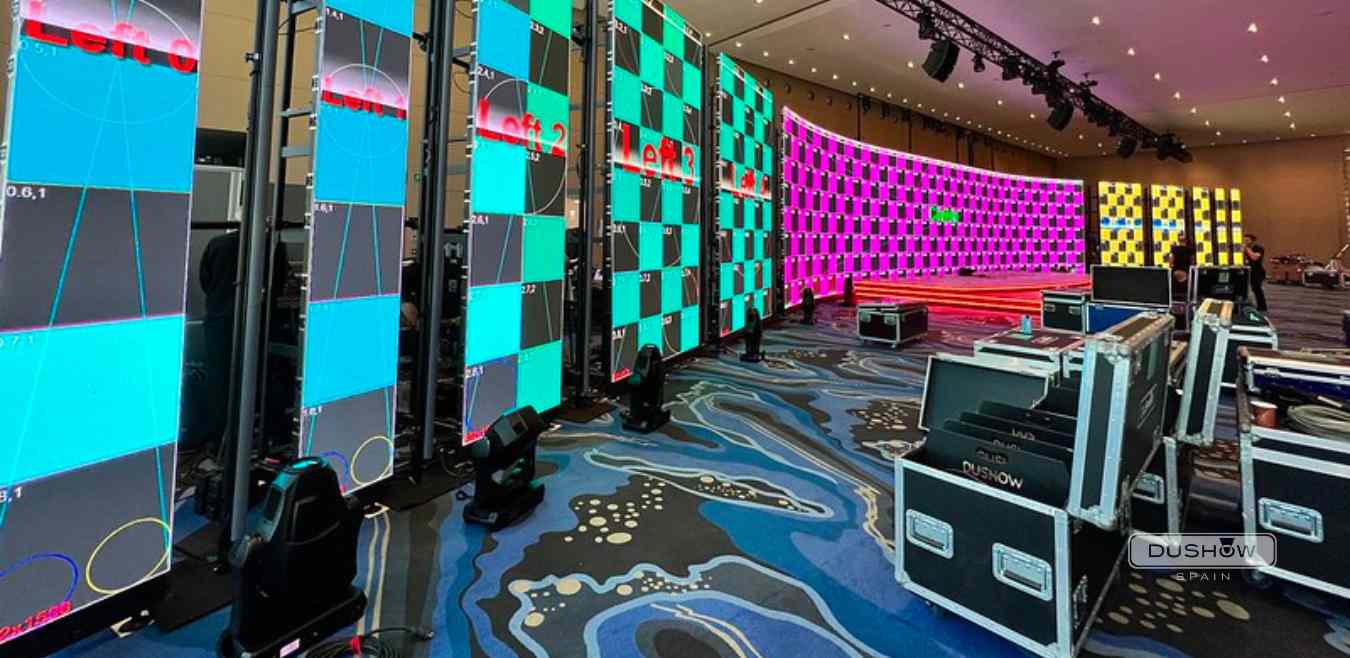Dushow Spain is now Novelty Spain
Organizing an event with your AV Partner: 10 technical key terms
In the process of organizing your event, it's crucial that everyone be familiar with the technical terms involved in event production.
Clear, efficient understanding among all those participating in setting up the event is vital for the optimal organization of partners, attendees and all other production service providers.

We're aware of how difficult it can be to follow your audiovisual partners and the technical terminology they use in preparing their quotes, or even in an initial task distribution meeting. But thoroughly understanding the jargon will help do away with any margin for error when it comes to taking future actions.
This article will reveal 10 essential technical terms you should know when organizing an event with your AV Partner. Let's get started!
Backline
Backline is the technical term that refers to the instruments and/or amplifiers that make up the material required by a given group, for example a band, to be able to complete their performance. Oftentimes, because of how bulky and difficult to transport this equipment is, it is rented from local companies.
Beyond whoever is responsible for supplying the equipment, the technical details of the backline must be correctly outlined in the rider for the event, so that the "backliners" (technicians responsible for setting up and configuring the equipment) can complete their tasks following the appropriate instructions.
Gobo
This technical term refers to a kind of decorative light device you can customize for your event.
Specifically, a gobo is a metal or glass element that, when placed between a light source and a space where the light is projected, generates a silhouette with the motif or design that has been cut out of the plate.
Our ancestors were already practising this same storytelling technique, using fire as a light source. Today it can be used for projecting the logos at any kind of event, or in commercial premises, as well as mapping to façades, ceilings and other surfaces with shapes and textures to provide personalized, unique ambient lighting.
Using a gobo will give you access to a broad array of functionalities, both in creating the dies (which are becoming more versatile) and in choosing the projection surface, with very few limitations, and significant range (as far as the light can travel).
Rigging
Oftentimes, in the effort to optimize space, for special technical and visual needs, it is decided to hang certain elements from the walls or ceiling, and that way make the most of the entire space in a venue. This is when rigging comes into play.
This technical term from the event organization world refers to all of the engineering necessary to hang equipment from different structures, while ensuring complete safety of event participants.
These important calculations are made by technicians specialized in the subject matter, and are based on documents provided by the venue, in the form of blueprints, CAD drawings or other schematic diagrams.
Consumables
Consumables are the elements necessary for the use of different equipment, which have a finite service life (in other words, a certain number of hours). They are generally used up during the production of a single event (and often more than once). These elements include, among others, filters for lights, batteries for microphones, the liquid necessary for smoke machines, electrical tape, etc.
You will find this technical term included in the quote for the organization of your event, as it is an investment that your AV supplier has to make to carry out their work.
Truss
You have probably been to an event, concert or play where you've seen different structures made of triangular braces hanging from the ceiling, with audiovisual equipment attached to them. In the event world, these are called trusses.
This technical term refers to structures (usually made of aluminium for their easy handling and durability) that may serve different functions. The main purpose of a truss is to enable optimal arrangement of audiovisual equipment.
Trusses come with a broad range of specifications (sizes, shapes, levels of resistance, etc.) and their use depends to a large degree on the technical needs of your event.
Technical control / FOH
This form of technical control is known by the acronym FOH, "front of house": this term is used to refer to the area where the audio and lighting desks are installed.
It is usually set up in the centre, between the left and right-side speakers, to give the technicians the best listening point from which to conduct the event.
It is crucial to attain excellent-quality event production.
Microphones: main types
Microphones are the first (and most vital) elements in the entire chain of pick-up, processing and distribution of sound. Their proper selection and use can determine the entire outcome of an event, which is why knowing these technical terms is extremely important to fully grasp the suggestions and proposals made by your AV partner. In general terms, there are three types of microphone, based on their polar patterns:
Omnidirectional
As their name suggests, this type of microphone picks up sound from any direction. On the upside, you don't have to worry about precisely positioning the microphone with respect to the speaker. The downside is that these microphones do not discriminate the sound you don't want to be replayed through the speakers, especially noise (which is defined as any undesired sound).
Cardioid
This is the best-suited for events, as it concentrates its pick-up capability in a given direction. That said, the speaker must bear this feature in mind to use the equipment in an optimal way.
Hypercardioid
These stand for an evolution in precision and delicacy of the previous category. These microphones bring a high level of directional precision, but at the same time, must be used in a carefully thought-out manner.
Beyond their polar pattern, microphones can be classified by how they are commonly used.
Handheld microphone
The best-known, and most common event microphone. As its name states, it's a microphone held in the user's hand.
Lapel
It's also known as a lavalier microphone. It consists of a fairly small microphone that is affixed to the speaker's clothing, relatively close to their mouth.
Headset
A headset microphone is worn on the speaker's head.
PA
Public Address (PA) is the technical term used to designate the main sound distribution system at an event.
A minimal system will be made up of all the audio pick-up and/or reproduction systems (microphones or other sources such as computers, players, etc.), the signal processing systems (the simplest: a single sound desk) that end up being distributed from a set of speakers that, as speaker boxes (a speaker is always associated with a speaker box) project the sound to the audience. Although we will see later how baffles are used for different purposes, the term Public Address (PA) is applied to those directly used to cover the area where the audience is.
This system is the one that generally uses the most power, as it is meant to reach every person in the event audience.
Do you have a glossary of technical terms you'll need to organize your event?
As you probably already know, in the event sector, and especially the part concerned with audiovisual technology and equipment, there is a wide range of technical terms that you often need to know.
At Dushow, we work to ensure completely transparent communication so all of the professionals behind an event are aligned, and working in the same direction. If you've found this article useful, make sure to visit our blog to learn about more key concepts.
This article was first published in Dushow Spain, you can read the original Spanish version here.




